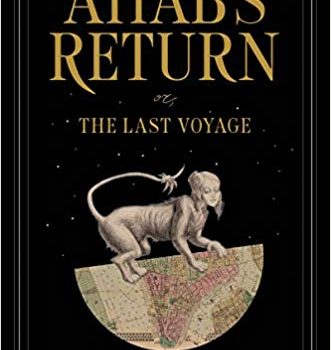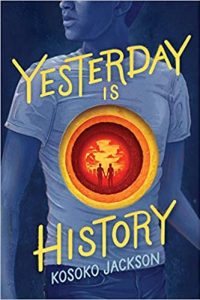Gary K. Wolfe Reviews Ahab’s Return by Jeffrey Ford
 Ahab’s Return, Jeffrey Ford (William Morrow 978-0-06-267900-0, $26.99, 262pp, hc) August 2018
Ahab’s Return, Jeffrey Ford (William Morrow 978-0-06-267900-0, $26.99, 262pp, hc) August 2018
One of the dependable pleasures of Jeffrey Ford’s work, apart from his precise and lyrical prose and generally ingratiating characters, is its acute sense of place, from the Long Island of his childhood to the small-town upstate New York of last year’s The Twilight Pariah. More often than not, these settings seem awash in immanence, conveying a haunting sense of unseen presence even before things get really weird. He’s been particularly attracted, it seems, to New York City, which he portrayed during the Depression in The Girl in the Glass and in its Gilded Age in The Portrait of Mrs. Charbuque. Ahab’s Return is another dive into New York history, this time back to the 1850s, focusing in part on the notorious Five Points neighborhood that so fascinated Martin Scorsese in Gangs of New York. Those with residual guilt over never having actually finished (or even started) Moby-Dick can rest assured that only common knowledge of that novel is needed to understand this one: namely, that Ahab was epically annoyed by a white whale, was apparently killed by it along with his crew, and that the tale was told by the lone survivor Ishmael. Those who did read the novel might be surprised that the once imperious and remote Ahab is sad and subdued in Ford’s sequel (though he’s still pretty obsessive), while Ishmael has been reduced to a rather pathetic minor role, and the third character carried over from Moby-Dick, the African harpooneer Daggoo, emerges as one of the most competent figures in the tale, under his real Mandinka name of Madi. In fact, the novel is generally less redolent of Moby-Dick than of Melville in his weirdly Gothic mode in novels like Pierre; or The Ambiguities or stories like “Bartleby, the Scrivener”. Bartleby even shows up briefly, only now his recalcitrant passivity has been transformed into full zombie mode.
The new characters that Ford introduces are more recognizably products of the dark, gritty urban underground of pre-Civil War New York. George Harrow, the narrator, is a hard-drinking tabloid reporter for the sensationalist newspaper The Gorgon’s Mirror – though “reporter” is a bit of an exaggeration, since he generally weaves his exploitative horror tales from whole cloth. When Ahab shows up at his office looking for Ishmael – the author of Moby-Dick, which he feels badly misrepresented him, and who once worked at the paper – Harrow realizes that he may have a promising new story. Ahab, it turns out, had indeed ended up in the whale’s mouth, but escaped and was rescued by fishermen from the Gilbert Islands, eventually making his way to Australia and finally to Nantucket – only to discover that his wife and son Gabriel, believing him dead, had moved to New York. Harrow decides to accompany Ahab on his quest to find them, and it doesn’t take long to discover that the wife is dead and the son involved with a terrifying children’s street gang, the Jolly Host – whose leader, known as Malbaster or the Pale King Toad, is reputed to have supernatural powers. In trying to track down Gabriel, Ahab and Harrow are assisted by the tough-minded and very resourceful teenage girl messenger Mavis – whose network of street urchins constitute a kind of Baker Street Irregulars – as well as a beautiful novelist named Arabella Dromen, Madi, and his African-American companion Fergus, all of whom have their own reasons for wanting to track down Malbaster.
As the adventurers encounter increasingly horrifying and bizarre figures – including that zombified Bartleby and even a manticore whose bite seems to simply erase people bit by bit – Ford begins to insinuate a broader critique of this brutal New York culture and America in general, sometimes rather bluntly. “I’m shattered not by Moby-Dick,” says Madi, “but something equally as large and white and ominous. What’s slain me is the treatment of the African in America.” The Jolly Host, for their part, are allied with those who target not only blacks, but the Irish, Germans, and Catholics, as well. “This unfounded fear of the papacy will pass in a decade, and when it does, the Irish and Germans will, after all, be white. Not so the blacks.” Lest we read this solely as an indictment of 19th-century racism, Ford gets even more pointed when describing the speeches that Malbaster occasionally gives to the Know-Nothing Party or other ersatz patriots:
His vocabulary was limited, but he spoke in such vague generalizations that the throngs of his compatriots found in his words enough room to nurture their own grievances and fears. His message was one of selfishness. “Life and resources and wealth are limited. They should be only for those of us who resemble those of us. All others should be driven out and/or disposed of.” A simple enough ideology for the masses.
As effective as Ahab’s Return is as a fast-paced and efficient thriller, it’s also a sharply critical fiction, raising issues of addiction, homelessness, and demagoguery, with the metaphysical whiteness of Melville’s whale replaced by the more toxic whiteness of “Me First” and “a quest for the reclamation of white Protestant superiority.” Manticores and gangsters might make for hazardous adventures in a steampunk past, but the actual horrors have never really gone away.
Gary K. Wolfe is Emeritus Professor of Humanities at Roosevelt University and a reviewer for Locus magazine since 1991. His reviews have been collected in Soundings (BSFA Award 2006; Hugo nominee), Bearings (Hugo nominee 2011), and Sightings (2011), and his Evaporating Genres: Essays on Fantastic Literature (Wesleyan) received the Locus Award in 2012. Earlier books include The Known and the Unknown: The Iconography of Science Fiction (Eaton Award, 1981), Harlan Ellison: The Edge of Forever (with Ellen Weil, 2002), and David Lindsay (1982). For the Library of America, he edited American Science Fiction: Nine Classic Novels of the 1950s in 2012, with a similar set for the 1960s forthcoming. He has received the Pilgrim Award from the Science Fiction Research Association, the Distinguished Scholarship Award from the International Association for the Fantastic in the Arts, and a Special World Fantasy Award for criticism. His 24-lecture series How Great Science Fiction Works appeared from The Great Courses in 2016. He has received six Hugo nominations, two for his reviews collections and four for The Coode Street Podcast, which he has co-hosted with Jonathan Strahan for more than 300 episodes. He lives in Chicago.
This review and more like it in the August 2018 issue of Locus.
 While you are here, please take a moment to support Locus with a one-time or recurring donation. We rely on reader donations to keep the magazine and site going, and would like to keep the site paywall free, but WE NEED YOUR FINANCIAL SUPPORT to continue quality coverage of the science fiction and fantasy field.
While you are here, please take a moment to support Locus with a one-time or recurring donation. We rely on reader donations to keep the magazine and site going, and would like to keep the site paywall free, but WE NEED YOUR FINANCIAL SUPPORT to continue quality coverage of the science fiction and fantasy field.







